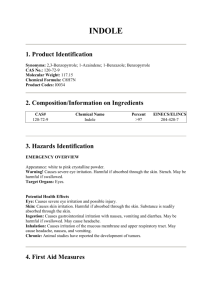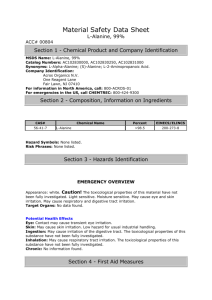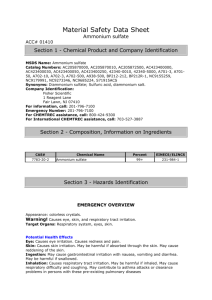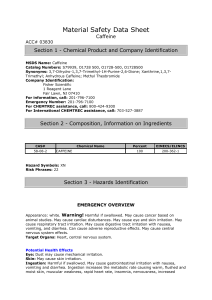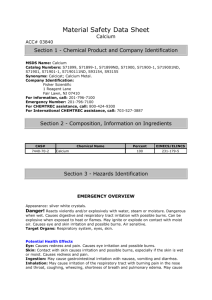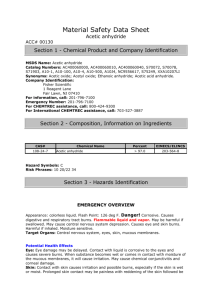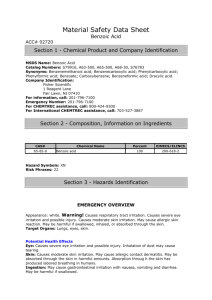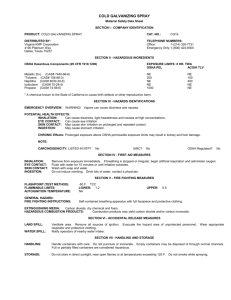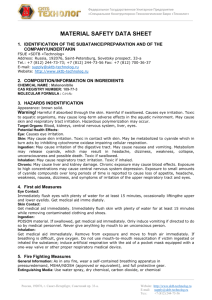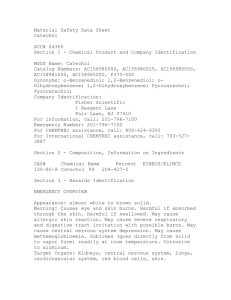Material Safety Data Sheet n-Butyric acid, 99+% ACC# 03680
advertisement
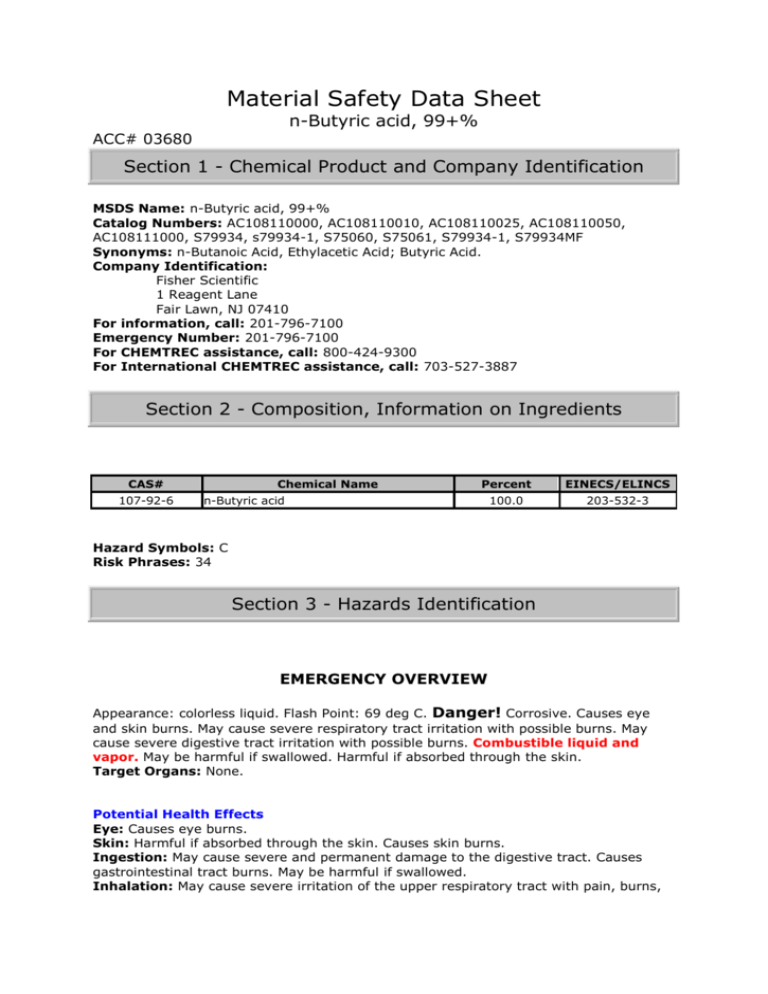
Material Safety Data Sheet n-Butyric acid, 99+% ACC# 03680 Section 1 - Chemical Product and Company Identification MSDS Name: n-Butyric acid, 99+% Catalog Numbers: AC108110000, AC108110010, AC108110025, AC108110050, AC108111000, S79934, s79934-1, S75060, S75061, S79934-1, S79934MF Synonyms: n-Butanoic Acid, Ethylacetic Acid; Butyric Acid. Company Identification: Fisher Scientific 1 Reagent Lane Fair Lawn, NJ 07410 For information, call: 201-796-7100 Emergency Number: 201-796-7100 For CHEMTREC assistance, call: 800-424-9300 For International CHEMTREC assistance, call: 703-527-3887 Section 2 - Composition, Information on Ingredients CAS# 107-92-6 Chemical Name Percent EINECS/ELINCS 100.0 203-532-3 n-Butyric acid Hazard Symbols: C Risk Phrases: 34 Section 3 - Hazards Identification EMERGENCY OVERVIEW Appearance: colorless liquid. Flash Point: 69 deg C. Danger! Corrosive. Causes eye and skin burns. May cause severe respiratory tract irritation with possible burns. May cause severe digestive tract irritation with possible burns. Combustible liquid and vapor. May be harmful if swallowed. Harmful if absorbed through the skin. Target Organs: None. Potential Health Effects Eye: Causes eye burns. Skin: Harmful if absorbed through the skin. Causes skin burns. Ingestion: May cause severe and permanent damage to the digestive tract. Causes gastrointestinal tract burns. May be harmful if swallowed. Inhalation: May cause severe irritation of the upper respiratory tract with pain, burns, and inflammation. Causes chemical burns to the respiratory tract. Chronic: No information found. Section 4 - First Aid Measures Eyes: Immediately flush eyes with plenty of water for at least 15 minutes, occasionally lifting the upper and lower eyelids. Get medical aid immediately. Do NOT allow victim to rub or keep eyes closed. Extensive irrigation with water is required (at least 30 minutes). Skin: Get medical aid immediately. Immediately flush skin with plenty of soap and water for at least 15 minutes while removing contaminated clothing and shoes. Wash clothing before reuse. Destroy contaminated shoes. Ingestion: Do NOT induce vomiting. If victim is conscious and alert, give 2-4 cupfuls of milk or water. Never give anything by mouth to an unconscious person. Get medical aid immediately. Inhalation: Get medical aid immediately. Remove from exposure to fresh air immediately. If not breathing, give artificial respiration. If breathing is difficult, give oxygen. Do NOT use mouth-to-mouth resuscitation. If breathing has ceased apply artificial respiration using oxygen and a suitable mechanical device such as a bag and a mask. Notes to Physician: Treat symptomatically and supportively. Section 5 - Fire Fighting Measures General Information: As in any fire, wear a self-contained breathing apparatus in pressure-demand, MSHA/NIOSH (approved or equivalent), and full protective gear. During a fire, irritating and highly toxic gases may be generated by thermal decomposition or combustion. Use water spray to keep fire-exposed containers cool. Combustible Liquid. Containers may explode when heated. Extinguishing Media: In case of fire, use water, dry chemical, chemical foam, or alcohol-resistant foam. Use water spray to cool fire-exposed containers. Water may be ineffective. Section 6 - Accidental Release Measures General Information: Use proper personal protective equipment as indicated in Section 8. Spills/Leaks: Absorb spill with inert material (e.g. vermiculite, sand or earth), then place in suitable container. Use water spray to dilute spill to a non-flammable mixture. Avoid runoff into storm sewers and ditches which lead to waterways. Clean up spills immediately, observing precautions in the Protective Equipment section. Use water spray to disperse the gas/vapor. Remove all sources of ignition. Use a spark-proof tool. Absorb spill with an alkaline material such as soda ash or lime. Carefully scoop up and place into appropriate disposal container. Provide ventilation. Section 7 - Handling and Storage Handling: Wash thoroughly after handling. Use only in a well-ventilated area. Ground and bond containers when transferring material. Do not get in eyes, on skin, or on clothing. Empty containers retain product residue, (liquid and/or vapor), and can be dangerous. Keep container tightly closed. Avoid contact with heat, sparks and flame. Do not ingest or inhale. Discard contaminated shoes. Do not pressurize, cut, weld, braze, solder, drill, grind, or expose empty containers to heat, sparks or open flames. Storage: Keep away from heat, sparks, and flame. Keep away from heat and flame. Keep away from sources of ignition. Do not store in direct sunlight. Keep container closed when not in use. Store in a tightly closed container. Keep from contact with oxidizing materials. Store in a cool, dry, well-ventilated area away from incompatible substances. Section 8 - Exposure Controls, Personal Protection Engineering Controls: Facilities storing or utilizing this material should be equipped with an eyewash facility and a safety shower. Local exhaust may be necessary to control concentrations to acceptable levels. Exposure Limits Chemical Name n-Butyric acid ACGIH none listed NIOSH OSHA - Final PELs none listed none listed OSHA Vacated PELs: n-Butyric acid: No OSHA Vacated PELs are listed for this chemical. Personal Protective Equipment Eyes: Wear appropriate protective eyeglasses or chemical safety goggles as described by OSHA's eye and face protection regulations in 29 CFR 1910.133 or European Standard EN166. Skin: Wear appropriate protective gloves to prevent skin exposure. Clothing: Wear appropriate protective clothing to minimize contact with skin. Respirators: A respiratory protection program that meets OSHA's 29 CFR §1910.134 and ANSI Z88.2 requirements or European Standard EN 149 must be followed whenever workplace conditions warrant a respirator's use. Follow the OSHA respirator regulations found in 29CFR 1910.134 or European Standard EN 149. Always use a NIOSH or European Standard EN 149 approved respirator when necessary. Section 9 - Physical and Chemical Properties Physical State: Liquid Appearance: colorless liquid Odor: unpleasant odor - putrid odor pH: Not available. Vapor Pressure: .43 mm Hg @20C Vapor Density: 3.0 (air=1) Evaporation Rate:Not available. Viscosity: 1.6 mPas 20 deg C Boiling Point: 162 - 165 deg C @ 760.00mm Hg Freezing/Melting Point:-7 - -5 deg C Autoignition Temperature: 425 deg C ( 797.00 deg F) Flash Point: 69 deg C ( 156.20 deg F) Decomposition Temperature:Not available. NFPA Rating: (estimated) Health: 3; Flammability: 2; Reactivity: 0 Explosion Limits, Lower:2.00 vol % Upper: 10.00 vol % Solubility: miscible with almost all common organic Specific Gravity/Density:.9640g/cm3 Molecular Formula:C4H8O2 Molecular Weight:88.11 Section 10 - Stability and Reactivity Chemical Stability: Stable. Conditions to Avoid: Incompatible materials, ignition sources, excess heat, alkaline materials, oxidizers. Incompatibilities with Other Materials: Oxidizing agents Hazardous Decomposition Products: Carbon monoxide, irritating and toxic fumes and gases, carbon dioxide. Hazardous Polymerization: Has not been reported. Section 11 - Toxicological Information RTECS#: CAS# 107-92-6: ES5425000 LD50/LC50: CAS# 107-92-6: Draize test, rabbit, skin: 20 mg/24H Moderate; Oral, rat: LD50 = 2 gm/kg; Skin, rabbit: LD50 = 530 uL/kg;<BR. Carcinogenicity: CAS# 107-92-6: Not listed by ACGIH, IARC, NIOSH, NTP, or OSHA. Epidemiology: No information available. Teratogenicity: No information available. Reproductive Effects: No information available. Neurotoxicity: No information available. Mutagenicity: DNA damage(Human HeLa cell) = 3 mmol/LDNA inhibition(Human Lymphocyte) = 4 mmol/L Other Studies: Standard Draize Test: Administration onto the skin (rabbit) = 500 mg/24H (Moderate). Section 12 - Ecological Information Ecotoxicity: Fish: Bluegill/Sunfish: LC50 = 200 mg/L; 24 Hr.; Unspecified flea EC50 = 61 mg/L; 48 Hr.; Unspecified ria: Phytobacterium phosphoreum: EC50 = 16.9 - 17.2 mg/L; 5,15, 30 Minutes; Microtox test, 15 degrees C No data available. Environmental: If released to soil, butyric acid is expected to be relatively mobile, although adsorption may occur by attractive interactions with active sites in the soil. Butyric acid is not expected to significantly volatilize from either moist or dry soil to the atmosphere. If released to water, butyric acid will exist predominately in the dissociated form under environmental conditions. Butyric acid is expected to biodegrade rapidly under both aerobic and anaerobic conditions. Physical: BOD: 1.150 lb/lb, 5 days; 1.450 lb/lb, 20 days. Other: No information available. Section 13 - Disposal Considerations Chemical waste generators must determine whether a discarded chemical is classified as a hazardous waste. US EPA guidelines for the classification determination are listed in 40 CFR Parts 261.3. Additionally, waste generators must consult state and local hazardous waste regulations to ensure complete and accurate classification. RCRA P-Series: None listed. RCRA U-Series: None listed. Section 14 - Transport Information US DOT Shipping Name: Hazard Class: UN Number: IATA RID/ADR IMO BUTYRIC ACID 8 Canada TDG BUTYRIC ACID 8 UN2820 Packing Group: III UN2820 II Section 15 - Regulatory Information US FEDERAL TSCA CAS# 107-92-6 is listed on the TSCA inventory. Health & Safety Reporting List None of the chemicals are on the Health & Safety Reporting List. Chemical Test Rules None of the chemicals in this product are under a Chemical Test Rule. Section 12b None of the chemicals are listed under TSCA Section 12b. TSCA Significant New Use Rule None of the chemicals in this material have a SNUR under TSCA. SARA Section 302 (RQ) CAS# 107-92-6: final RQ = 5000 pounds (2270 kg) Section 302 (TPQ) None of the chemicals in this product have a TPQ. SARA Codes CAS # 107-92-6: acute, flammable. Section 313 No chemicals are reportable under Section 313. Clean Air Act: This material does not contain any hazardous air pollutants. This material does not contain any Class 1 Ozone depletors. This material does not contain any Class 2 Ozone depletors. Clean Water Act: CAS# 107-92-6 is listed as a Hazardous Substance under the CWA. None of the chemicals in this product are listed as Priority Pollutants under the CWA. None of the chemicals in this product are listed as Toxic Pollutants under the CWA. OSHA: None of the chemicals in this product are considered highly hazardous by OSHA. STATE CAS# 107-92-6 can be found on the following state right to know lists: California, New Jersey, Florida, Pennsylvania, Massachusetts. California No Significant Risk Level: None of the chemicals in this product are listed. European/International Regulations European Labeling in Accordance with EC Directives Hazard Symbols: C Risk Phrases: R 34 Causes burns. Safety Phrases: S 26 In case of contact with eyes, rinse immediately with plenty of water and seek medical advice. S 36 Wear suitable protective clothing. S 45 In case of accident or if you feel unwell, seek medical advice immediately (show the label where possible). WGK (Water Danger/Protection) CAS# 107-92-6: 1 Canada CAS# 107-92-6 is listed on Canada's DSL List. CAS# 107-92-6 is listed on Canada's DSL List. This product has a WHMIS classification of B3, E. CAS# 107-92-6 is listed on Canada's Ingredient Disclosure List. Exposure Limits CAS# 107-92-6: OEL-RUSSIA:STEL 10 mg/m3 Section 16 - Additional Information MSDS Creation Date: 5/17/1999 Revision #2 Date: 8/02/2000 The information above is believed to be accurate and represents the best information currently available to us. However, we make no warranty of merchantability or any other warranty, express or implied, with respect to such information, and we assume no liability resulting from its use. Users should make their own investigations to determine the suitability of the information for their particular purposes. In no event shall Fisher be liable for any claims, losses, or damages of any third party or for lost profits or any special, indirect, incidental, consequential or exemplary damages, howsoever arising, even if Fisher has been advised of the possibility of such damages.


